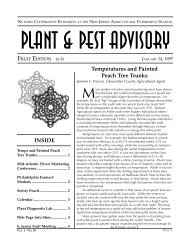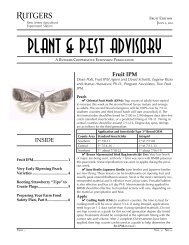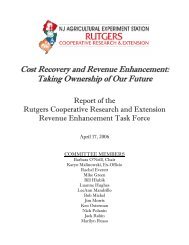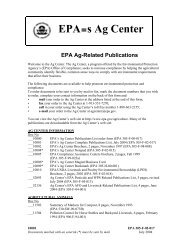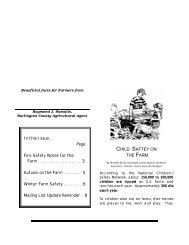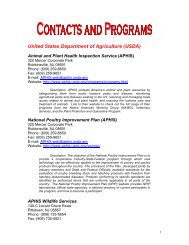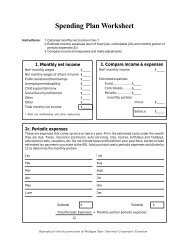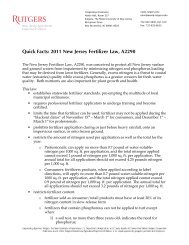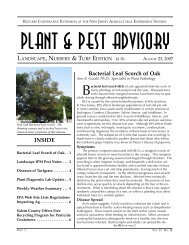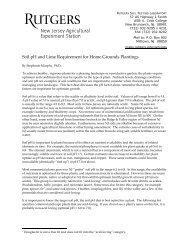Irrigation Log Charts - Rutgers New Jersey Agricultural Experiment ...
Irrigation Log Charts - Rutgers New Jersey Agricultural Experiment ...
Irrigation Log Charts - Rutgers New Jersey Agricultural Experiment ...
Create successful ePaper yourself
Turn your PDF publications into a flip-book with our unique Google optimized e-Paper software.
Drip <strong>Irrigation</strong> Management Example<br />
for Vegetables<br />
<strong>Irrigation</strong> wetting to the proper effective<br />
soil rooting depth (varies by crop) is<br />
recommended on or before soils are ½<br />
depleted of their available soil water. For<br />
example, wetting soil to 12 inches for<br />
shallow rooted crops needs from 1/3 inch<br />
of water on coarse sandy loam soils to 3/4<br />
inch on loam soils. This affects how many<br />
hours the system is run. The <strong>Rutgers</strong><br />
Commercial Vegetable Production<br />
Recommendations has tables to simplify<br />
calculations.<br />
Drip emitter rates vary. A typical 0.5<br />
gpm/100 row ft. drip line on 5 ft. row<br />
centers is about 8,500 row ft/acre and uses<br />
42.5 gpm (2,550 gph).<br />
One acre inch of irrigation water is 27,150<br />
gallons. Using the example of 0.5 gpm drip<br />
line above we can calculate the gallons<br />
needed and run time.<br />
27,150 g/acre inch x .33 inch = 8,960<br />
g/acre needed per irrigation to irrigate<br />
sandy soils and 20,363 g/acre (27,150<br />
g/acre inch x .75 inch) to wet loam soils to<br />
12 inch depth.<br />
8,960 g/acre ÷ 2,550 gph emitted = 3.5<br />
minimum hours run time for 1/3 inch<br />
irrigation. More frequent irrigations of less<br />
duration will not wet soil to desired rooting<br />
depth.<br />
To figure out how many emitters you have<br />
per acre, find out the spacing of emitters<br />
on the drip tape and the total row feet you<br />
have per acre. After finding out how many<br />
total row feet per acre, divide that number<br />
by the spacing between emitters. If you<br />
had a 12 inch spacing between emitters<br />
and 8,500 row feet per acre, the calculation<br />
would be 8,500 ÷ 12 =708 emitters per<br />
acre.<br />
During peak summer growth with no<br />
rainfall, the crop soils will need at least 1.4<br />
inches/week (0.2 inch/day) of water. If 3.5<br />
hours delivers .33 inch, then it requires a<br />
minimum of about 15 hours weekly run<br />
time to deliver 1.4 inches. This could be<br />
done with 5 hours on alternate days to<br />
make management more convenient.<br />
Check soils with tensiometers, watermark<br />
sensors or by feel to adjust irrigation run<br />
times as needed. Some growers are also<br />
utilizing evapo-transpiration models to<br />
schedule irrigation.<br />
We do not generally consider infiltration<br />
rates when drip irrigating in southern <strong>New</strong><br />
<strong>Jersey</strong>. However caution should be used to<br />
not overwater (i.e., use excessive run<br />
times) on clay or compacted soils or if<br />
there is risk of Phytophthora blights.<br />
Excessive run times can move the water<br />
and nutrients past the root zone.



